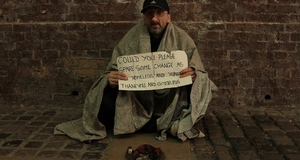As others cited above have shown, homelessness among minorities is tied to social exclusion in other aspects of their quality of life such as employment, political participation, and interaction with other groups in society. From an international human rights standpoint, nondiscrimination is essentially a civil/political right and housing is a social/economic right. These two sets of rights are interrelated, hence certain violations such as discrimination affect the enjoyment of other rights such as housing; this relationship explains the overrepresentation of people of color among the homeless.
One example is the fact that a large segment of homeless black men have been in the criminal justice system, as highlighted by Rosenheck et al (1998, 20). There is a body of scholars whose research has found discrimination and racial bias in the U.S. criminal justice system, which lead to an overrepresentation of African Americans in jails (Michelle Alexander, David Jacobs & Richard Kleban, Nicola Lacey, Peter Marcuse). Pettit and Western investigated the lifetime risks of imprisonment for black and white men at different levels of education, assuming that imprisonment, college graduation, and military service are passages into adulthood in one’s lifecourse, affecting overall life trajectory and quality of life, such as gaining stable employment. Pettit and Western found that by 1999, imprisonment had become a common life event for non-college educated black men, more frequent than military service or college education (Pettit and Western 2004, 164). They found that 1/3 of non-college educated black men had been to prison, while few non-college educated white men did. Whites in their early 30s were twice as likely to earn a BA (Pettit and Western 2004, 164).
The interaction with the criminal justice system has been found to be a marginalizing factor. Devah Pager conducted a study producing direct evidence that ex offenders were only half to a third as likely as non-offenders to be considered by employers (Pager 2003, 961). Furthermore, she found that blacks with a criminal record are less than half as likely to be considered by employers as whites with a record, and that blacks without a record are less likely to be considered as whites with a record (Pager 2003, 961). These studies and conclusions show that there is a strong link between civil rights and economic and social rights, which can explain why minorities are overrepresented among the homeless.
In order to understand the human rights framework, it is important to mention the origins of human rights. Modern human rights can be traced to the 18th century Enlightenment. John Locke wrote about natural rights and natural law; Immanuel Kant wrote about “universalisable duties” people owe to each other and constraints that limit the actions that can be taken against individuals (Fitzpatrick and Watts 2010, 108). Modern human rights are more comprehensive and did not come about until the post World War II era. Political realities led to the separation of civil/political rights from economic/social rights. Western countries only recognized civil and political rights. The Soviet bloc only recognized economic and social rights (Donnelly 2003, 33). This schism led to the creation of two separate documents, and the option for governments to pick and chose enforcement of human rights. Nondiscrimination is found in the International Covenant on Civil and Political Rights, article 26:
All persons are equal before the law and are entitled without any discrimination to the equal protection of the law. In this respect, the law shall prohibit any discrimination and guarantee to all persons equal and effective protection against discrimination on any ground such as race, color, sex, language, religion, political or other opinion, national or social origin, property, birth or other status (ICCPR, 1966).
The right to housing is found in article 11 of the International Covenant on Economic and Social Rights:
The States Parties to the present Covenant recognize the right of everyone to an adequate standard of living for himself and his family, including adequate food, clothing and housing, and to the continuous improvement of living conditions. The States Parties will take appropriate steps to ensure the realization of this right, recognizing to this effect the essential importance of international co-operation based on free consent (ICESCR, 1966).
In addition, a plethora of international documents encompass the right to housing and nondiscrimination:
- International Convention on the Elimination of All Forms of Racial Discrimination
- UN General Comment No.4 on the Right to Adequate Housing
- UN Convention on the Elimination of All Forms of Discrimination Against Women
- International Convention on the Protection of the Rights of All Migrant Workers
- European Social Charter and the Collective Complaints Protocol
- European Convention on Human Rights
- 2000 EU Race Directive
- EU Charter of Fundamental Rights
- EU Social Protection and Social Inclusion Strategy
Therefore, I draw from Marcuse, Rosenheck et al, Tilly, Pager, and Pettit and Western, and combine durable inequality with the human rights framework. The human rights framework approaches minority homelessness within the context of social exclusion, and denials of civil and political rights affecting the enjoyment of other economic and social rights. Tilly’s durable inequality framework provides the deeper understanding of why such violations occur for some and not others. The human rights framework complements Tilly’s contribution by providing the mechanisms that change the benefits associated with exploitative set ups Tilly discusses in seeking to challenge durable inequality.
I argue that individual factors interact with structural factors such as poverty to push already marginalized people into homelessness. While poverty, neoliberal policies, and individual-level factors may increase vulnerability to homelessness, minorities are overrepresented in all cases because of durable inequality and social exclusion which lead to these factors impacting some groups more severely than others. The following section discusses the methodology I used to conduct the research.Continued on Next Page »
Axelson, Leland J., and Paula W. Dail. 1988. “The Changing Character of Homelessness in the United States.” Family Relations 37: 463-469.
Bessant, Judith, Richard Hil and Rob Watts. 2003. “Discovering” Risk: Social Research and Policy Making. New York: Peter Lang.
Brent, Benda B., and Elizabeth D. Hutchinson. 1990. Homelessness and Alcohol. In Helping the Homeless: Where Do We Go from Here? ed. John R. Belcher and Frederick A. DiBlasio, 123-149. Lexington, Massachusetts/Toronto: Lexington Books.
Broin, Eoin O. 2008. “Can We End Long Term Homelessness By 2010?” Homeless in Europe Winter: 10-12.
Calavita, Kitty. 2005. Immigrants at the Margins: Law, Race, and Exclusion in Southern Europe. Cambridge: Cambridge University Press.
Council of Europe. European Committee of Social Rights. 2012. “Conclusions XIX-4, United Kingdom.”
Council of Europe. European Committee of Social Rights. 2012. “ Conclusions 2011-France.”
Council of Europe. European Committee of Social Rights. 2011. “Conclusions 2011-Italy”
Donnelly, Jack. 2003. Universal Human Rights in Theory and Practice. Ithaca and London: Cornell University Press
Duffield, Barbara. 2001. Poverty Amidst Plenty: Homelessness in the United States. In International Perspectives on Homelessness, ed. Valerie Polakow and Cindy Guillean, 195-215. Westport: Greenwood Press.
Edgar, Bill, et al. 2004. Immigration and Homelessness in Europe. Bristol: The Policy Press.
Edgar, Bill. 2009. “European Review of Statistics on Homelessness.” European Observatory on Homelessness.
European Commission Against Racism and Intolerance. 2010. “ECRI Report on the United Kingdom” < http://www.coe.int/t/dghl/monitoring/ecri/Country-by- country/United_Kingdom/GBR-CbC-IV-2010-004-ENG.pdf>
European Commission Against Racism and Intolerance. 2010. “ECRI Report on France” .
Feantsa.org. 2007. “France Adopts Justiciable Right to Housing.”
Fernandez, Manny. 2007. “Study Finds Disparities in Mortgages by Race.” New York Times <http://www.nytimes.com/2007/10/15/nyregion/15subprime.html?ex=1350187200&en=a9978e04a9864642&ei=5088&partner=rssnyt&emc=rss>
Fernandez, Guillem, and Marc Uhry. 2008. “The Housing Crisis and Homelessness.” Homeless in Europe Winter: 1-5.
Fitzpatrick, Suzanne, and Beth Wattz. 2010. “’The Right to Housing’ for Homeless People.” Homelessness Research in Europe.
Gauci, Jean-Pierre. 2011. Racism in Europe: ENAR Shadow Report 2010-2011. Brussels: European Network Against Racism.
Genzuk, Michael. 2003 “A Synthesis of Ethnographic Research.” Center for Multilingual, Multicultural Research. University of Southern California < http://www- bcf.usc.edu/~genzuk/Ethnographic_Research.html>.
Glasser, Irene. 1994. Homelessness in Global Perspective. New York: Macmillan Publishing Company.
Hope, Marjorie, and James Young. 1986. The Faces of Homelessness. Lexington: Lexington Books.
Hopper, Kim. 1991. “Research for What? Lessons From the Study of Homelessness.” Bulletin of the American Academy of Arts and Sciences 44:13-31.
Husain, Altaf. 2012. Interview by author. Washington, DC. June 21.
Marcuse, Peter. 1996. Space and Race in the Post-Fordist City: the Outcast Ghetto and Advanced Homelessness in the Advanced World Today. In Urban Poverty and the Underclass, ed. Enzo Mingione, 3-41. Oxford: Blackwell Publishers.
Migration Policy Institute. 2009. “United Kingdom: A Reluctant Country of Immigration.” Migration Information Source.
Mingione, Enzo. 1996. Urban Poverty in the Advanced Industrial World: Concepts, Analysis, and Debates. In Urban Poverty and the Underclass, ed. Enzo Mingione, 3-41. Oxford: Blackwell Publishers.
Mondloch, Kevin. 2012. Interview by author. Arlington, VA. July 9
National Alliance to End Homelessness. 2012. “The State of Homelessness in America: 2012.” Homelessness Research Institute.
National Coalition for the Homeless. 2009. “Foreclosure to Homelessness 2009.” www.nationalhomeless.org
National Coalition for the Homeless. 2009. How Many People Experience Homelessness?” http://www.nationalhomeless.org/factsheets/How_Many.html
Office of the High Commissioner for Human Rights. 2012. The International Covenant on Civil and Political Rights < http://www2.ohchr.org/english/law/ccpr.htm>.
Office of the High Commissioner for Human Rights. 2012. The International Covenant on Economic, Social, and Cultural Rights < http://www2.ohchr.org/english/law/cescr.htm>.
Pager, Devah. 2003. “The Mark of a Criminal Record.” The American Journal of Sociology 108 No.5: 937-975.
Pettit, Becky, and Bruce Western. 2004. “Mass Imprisonment and the Life Course: Race and Class Inequality in U.S. Incarceration.” American Sociological Review 69 No.2: 151-169.
Pleace, Nicholas. 2010. “Immigration and Homelessness.” Homelessness Research in Europe. Centre for Housing Policy, University of York.
Rosenheck, Robert, Ellen Bassuk and Amy Salomon. 1998. “Special Populations of Homeless Americans.” U.S. Department of Health and Human Services < http://aspe.hhs.gov/progsys/homeless/symposium/2-Spclpop.htm>
Shelter.org. 2012. Temporary Accommodation from the Council.
Shelter.org. 2011. “Am I Eligible for Assistance?”
Shinn, Marybeth. 2010. “Homelessness, Poverty, and Social Exclusion in the United States and Europe.” European Journal of Homelessness 4: 19-44.
Simon, Rita, and James Lynch. 1999. “A Comparative Assessment of Public Opinion toward Immigrants and Immigration Policies.” International Migration Review 33 no.2.
Substance Abuse and Mental Health Services Administration. 2012. Homelessness Resource Center. Homeless Populations
Substance Abuse and Mental Health Services Administration. 2011. “Current Statistics on the Prevalence and Characteristics of People Experiencing Homelessness in the United States.”
Susser, I. 1996. “The Construction of Poverty and Homelessness in U.S. Cities.” Annual Review of Anthropology 25: 411-435.
Tilly, Charles. 1999. Durable Inequality. Berkley; Los Angeles; London: University of California Press.
Toro, Paul A., et al. 2007. “Homelessness in Europe and the United States: A Comparison of Prevalence and Public Opinion.” Journal of Social Issues 63: 505-524.
U.S. Department of Housing and Urban Development. “The 2010 Annual Homeless Assessment Report to Congress.” June 2011.
U.S. Department of State. 2011. Bureau of Democracy, Human Rights, and Labor. Country Reports on Human Rights Practices for 2011. Italy
Wacquant, Loic J.D, and William Julius Wilson. 1989. “The Cost of Racial and Class Exclusion in the Inner-City.” The Ghetto Underclass: Social Science Perspectives 501, 8-25.
Wacquant, Loic J.D. 1996. “The Rise of Advanced Marginality: Notes on its Nature and Implications.” Acta Sociologica 39 no.2, 121-139.
Washington.org. 2012. “DC History.” Accessed July 13. http://www.washington.org/visiting/experience-dc/knowledge-seeker/dc-history-african- american
Wright, Talmadge. 2000. “Resisting Homelessness: Global, National, and Local Solutions.” Contemporary Sociology 29: 27-43.
1.) In the United Kingdom, statutory homeless are people that have a legal claim to housing as considered by the legal authorities. In order to be eligible, one must lack a secure place to live, must have dependent children, apply for homelessness assistance, prove unintentional homelessness, and must pass a series of tests (CRISIS, Statutory Homelessness, 2012. http://www.crisis.org.uk/pages/homeless-def-numbers.html#_ftn).
2.) This research was approved by the Institutional Research Board in the spring semester of 2012.
3.) Names of some participants are being kept confidential.



















